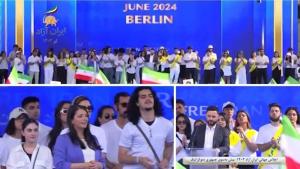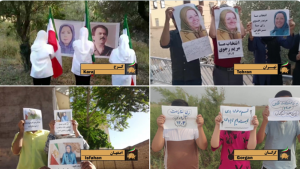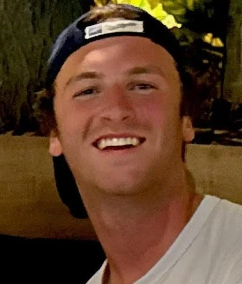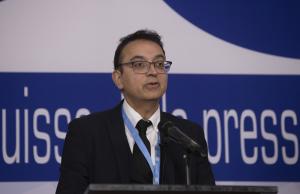
 On July 1, the third day of the Free Iran 2024 World Summit, titled “Iran:...
On July 1, the third day of the Free Iran 2024 World Summit, titled “Iran:... 

On July 1, the third day of the Free Iran 2024 World Summit, titled “Iran: “Crimes Against Humanity and Accountability for Perpetrators,” many participants endorsed Mr. Javaid Rehman’s report and the need to pursue and punish the perpetrators of this “genocide.”
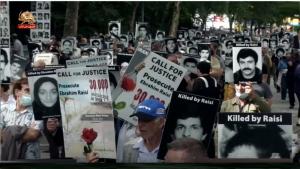
Khomeini’s aim in the 1988 massacre was not just revenge against the PMOI for their persistence and ideals. Khomeini feared his regime’s overthrow and believed that by killing PMOI members, he erase the memory of the 30,000 executed and extend his rule for years.
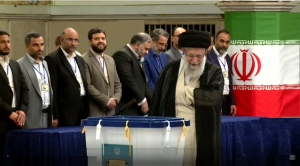
This is the same regime that has carried out hundreds of terrorist operations against members and supporters of the PMOI across the globe. Right now, the regime is not even adhering to its laws when it comes to PMOI members and the family members of the PMOI.
The bitter memories of the past four decades have not been erased from the memory of the Iranian people, and the rebellious generations inside and outside Iran.
— MEK
PARIS, FARANCE, July 15, 2024 /EINPresswire.com/ — The official website of the People’s Mojahedin Organization of Iran (PMOI/MEK) in an article published that a few weeks before the Free Iran 2024 Summit, Mr. Javaid Rehman, the UN Special Rapporteur on human rights in Iran, presented a new report describing the execution of political prisoners in the 1980s and the 1988 massacre as crimes against humanity and genocide.
On July 1, the third day of the Free Iran 2024 World Summit, titled “Iran: “Crimes Against Humanity and Accountability for Perpetrators,” many participants endorsed Mr. Javaid Rehman’s report and emphasized the need to pursue and punish the perpetrators of this “genocide.”
Ambassador Joachim Rueker, President of the UN Human Rights Council until 2015, said, ” Professor Javaid Rehman published or talked about a new landmark report in which he, according to reports, concluded that the 1988 massacre of thousands of political prisoners in Iran amounted to crimes against humanity. It is reported that he also mentioned genocide. This report must be out there for the public to see what the Special Rapporteur has found.”
Mr. Mark Ellis, Executive Director of the International Bar Association, emphasized the possibility of prosecuting the masterminds and perpetrators of the 1988 genocide, citing the example of Syria.
Dr. Wolfgang Schomburg, a former German Federal Judge, confirmed this and added there has been and still is a mechanism to hold these crimes accountable.
Other experts, including former UN rapporteurs, former ambassadors to the UN Human Rights Council, and former ministers of justice, also spoke, all indicating their belief in the legal victory of the Iranian people against the regime of executions and massacres.
Khomeini’s aim in the 1988 massacre was not just a hysterical reaction or revenge against the PMOI for their persistence and ideals. Khomeini feared his regime’s overthrow and believed that by an entire generation of PMOI members and supporters, he could erase the memory of the 30,000 dissidents from contemporary history and extend his rule for centuries.
One of the magnificent aspects of this year’s Free Iran Summit was that alongside the widespread campaigns of the Iranian people in political, legal, and other fields, new generations of PMOI supporters were present in various gatherings and conferences.
Wherever the cameras turned, teenagers and young people were actively participating to show their support for the Iranian Resistance and the Iranian people’s fight for freedom.
Many supporters attended the event with their families.
The youth held flags and pictures of Iranian Resistance leaders. Many of them are born abroad and have never seen Iran.
One of the most emotional and impactful speeches was delivered by a member of this new generation of resistance supporters, “Amineh Gharaei,” the daughter of a PMOI martyr executed during the 1988 massacre of political prisoners.
Her speech, filled with deep pain and unavenged grief, brought tears to many in the audience and was interrupted multiple times by applause and emotions. Especially when she recounted her childhood memories in “November 1988” and the “three consecutive months” of waiting outside the prison for news of her father’s condition, which ended “without any trace of his body, grave, or even a piece of his clothing.”
Fortunately and proudly, Amineh is now part of the resistance herself and proudly proclaims: “Today, I stand here. Alongside the glorious PMOI organization.
The same resistance whose name is the highest red line for the regime and today, I stand before you, PMOI, and you, dear Mrs. Maryam Rajavi, and I swear that the greatest honor of my life is knowing the Mojahedin and being alongside them.”
Amineh was not alone; others, such as Behrouz, accompanied her on behalf of his three martyred uncles, reminding and proving the longstanding message of the resistance leader: “Rest assured, for every hand of a Mojahed that is broken, ten more will be added. For every eye of a Mojahed that is taken out, a hundred more will be opened. And for every heart of a Mojahed that is torn and every head that is broken, a thousand more blessed hearts and heads will replace them.”
With this new and passionate generation that has overcome all storms of demonization, censorship, and silence, and is thwarting the regime’s schemes, with the multitude of young people inside the country joining the PMOI Resistance Units and those abroad who have forsaken the highest opportunities in the most advanced countries to join the resistance, with these noble children of the heroic people of Iran, who have now become the officials, managers, moderators, and organizers of the Iranian Resistance’s rallies, the outcome of Khomeini and Khamenei’s “genocide” has been nothing but the flourishing and promising future of a globally renowned democratic alternative.
The pain, blood, and bitter memories of the past four decades have not been erased from the collective memory of the Iranian people, and the rebellious generations inside and outside Iran stand defiantly against the decrepit regime, declaring, “We stand firm!”
One of the participants in the recent Free Iran 2024 World Summit was Mr. Francisco Guerreiro, a member of the European Parliament from Portugal. On July 1, in his speech about the “dream of the Iranian people” for freedom, he said, “I define the resistance movement in ‘hope, resilience, and vision.’ Hope, because we must continue to dream of a secular democracy.
This dream is not new; it began in the 1950s with Mossadegh. However, in 1953, this dream was shattered by a coup d’état orchestrated by Western forces, primarily the US and British, opposing this vision. We must politically recognize the National Council of Resistance of Iran (NCRI) as the sole entity capable of guiding Iran’s transition to a secular democracy.”
Two days after the grand gathering of the resistance, Mr. Guerreiro wrote on his X account: “Three words define the Iranian Resistance. Hope, Resilience, and Vision.”
The difference between fantasizing and having hope is vast. Fantasizing usually results from letting the mind wander in a world of illusions; a directionless world where no price is paid, and no specific action is taken.
There is no clear plan or roadmap for reaching a goal, and no collective effort and persistent work are required. It is like letting the imagination roam free in the vast meadows of unfulfilled desires and nothing more.
But hope exists in the hard world of realities. Realities outside the mind that flow in the political and social scene as a constant battle between exploiters and the exploited.
In this world, hope is the source of action and effective work, providing a vision. It polishes wills and gives people the power to rise and pave the way. With hope, the first rays of a path to salvation are instilled in the masses of the broken-hearted and the oppressed, creating a belief in change.
But why is “hope” the most prominent characteristic of the Iranian Resistance from the perspective of a politician who has recently become acquainted with this movement, and how has this Resistance been able to instill hope in hearts? What is that ever-burning furnace that has gathered masses of supporters of the Resistance in the Free Iran Summit?
The speakers who participated in the Summit each, in their own words, spoke about what had ignited the flame of hope in their hearts.
Ms. Michèle Alliot-Marie, a minister in several French governments, said, “In every resistance movement, it is crucial to see the positive. There is another path, the one you, Maryam Rajavi, have outlined with your Ten-Point Plan, embodying values essential for peace and prosperity. This hope exists and is recognized internationally, with more official voices denouncing Iran’s actions.”
General James Jones, former National Security Advisor to U.S. President Barrack Obama, emphasized, “The global community must be far, far more in support of the future envisioned by Mrs. Rajavi and the NCRI outlined in the Ten-Point Plan that has been discussed already.
The manifesto articulates the irrepressible hopes and aspirations of the Iranian people and all of those who have laid down their lives in protest of that tyranny.”
Ms. Nargis Nehan, former Minister of Mines and Petroleum of Afghanistan, said, “It is the resilience and resistance of the women of Iran and Afghanistan that give me hope and energy to stand here before you.
“I would like to conclude with three recommendations: first, please support Madam Rajavi’s Ten-point action plan if you truly want to secure a better future for Afghanistan. Second, please join our international campaign for the recognition of gender apartheid in Afghanistan and Iran.”
And others consider Mrs. Rajavi herself as a source of inspiration and hope. A long-time supporter of the Iranian resistance, Mrs. Betancourt, is one of them.
She said, “It is important to understand why the regime puts so much effort into stopping our support. First, it’s because if we succeed in obtaining official support from governments, it sends a message as powerful as a nuclear bomb. It means game over. Because Maryam Rajavi has given hope to the Iranian people. And hope among leaders in dictatorial regimes is what they fear most.”
This view is also seen in the words of Mr. Abdullah Hoti, former Prime Minister of Kosovo, who told Mrs. Rajavi, “Honorable Madam Rajavi, you have our sympathy and support, as always. And sometimes it might seem that your efforts are not bringing the change that you seek for your people. But remember that you are the only hope for millions of boys and girls who want to live a free and decent life.”
This Resistance movement, which is organized, has a plan, has a network of Resistance Units who are carrying out activities inside Iran every day, and a network of freedom-loving Iranians regularly holding rallies and conferences abroad, is constantly progressing.
Iran’s regime threatens diaspora with extradition following Free Iran rally
A few days after the Free Iran 2024 World Summit, in which a majority of 34 legislatures and 4,000 parliamentarians in 50 countries worldwide expressed their support for the Iranian people and their Resistance movement, on Tuesday, July 9, a minor cleric, acting as a judge in the theatrical “trial” of 104 members of the Iranian Resistance, reflected the fear of the regime and said:
“This court declares that if, from now on, Iranians abroad form or attend meetings anywhere in the world at the invitation of the defendants in this case, a red notice will be issued for them under international conventions; therefore, the head of this court asks the Attorney General and the Foreign Minister to ensure that if Iranians abroad attend any sessions at the invitation of the defendants in this case, it will be considered as support for the [People’s Mojahedin Organization of Iran (PMOI/MEK)] and they will be subject to criminal prosecution in court, and these individuals will be extradited to the country.”
Dehghani, the minor cleric judge of Khamenei, then absurdly addressed all countries with concern about the impact of the Free Iran event, saying: “This court warns statesmen of countries hosting terrorists that they must either prosecute the defendants themselves or extradite them to us.”
The cleric added: “I ask the Foreign Minister that from now on, if Iranians abroad attend any meetings at the invitation of the defendants in this case, it will be considered as a support for the [PMOI/MEK] and they will be subject to prosecution in this court.”
For further emphasis, he added: “The charge against the PMOI/MEK is ‘baghi’ (armed rebellion against the religious leader to disrupt the system’s security), and Muslims have to fight them. Being Muslim is irrelevant in cases of baghi or rebels. Simply rising against the Imam and the foundation of the government constitutes baghi, whether it succeeds or not.”
Then another cleric named Sedaghat, who presented himself as an expert in religious issues, elaborated on the discoveries of the judge: “This group is baghi, which is higher than mohareb (those who wage war against God); the actions of the PMOI members, in addition to being considered moharebeh (war against God), also constitute baghi.
Three conditions have been proposed for the realization of the religious conditions of baghi: First, they must have fortifications that make it impossible to repel their evil without fighting; second, they must be outside the realm of the Muslim Imam and have gathered together; third, their rebellion must be based on a false interpretation of the illegitimacy of the established government and their numbers must be such that it cannot be dealt with except through armed forces. All these conditions apply to the PMOI.”
Finally, the judge, in utter desperation and helplessness, said: “With full authority, I declare to the defendants in this case that they have the opportunity to return and defend themselves against the actions they have committed.”
It is worth mentioning that in the fifteenth session of the court, the cleric judge once again, in utmost shame and frustration, announced: “Not a single lawyer has been introduced to the court by any of the defendants, nor has any petition been submitted.”
This is the same regime that executed more than 30,000 political prisoners, mostly PMOI members, in the span of a few months in 1988 without giving them a fair trial.
This is the same regime that hunted down and killed PMOI members in the streets in the early 1980s. This is the same regime that has carried out hundreds of terrorist operations against members and supporters of the PMOI across the globe.
Right now, the regime is not even adhering to its laws when it comes to PMOI members, and it torments the family members of the Iranian Resistance just because they are related to the PMOI.
There is no such thing as justice under the rule of the mullahs. But the fake trial and the most recent threat the regime has issued against the supporters of the PMOI have one clear message: the regime knows its main threat and its alternative, the only organized resistance movement that can help the Iranian people overthrow the regime and establish a free and democratic republic.
And it will do anything to prevent their activities. Absent a firm policy by Western governments, the regime is using this court as an excuse to further expand its terrorist activities against the Iranian Resistance abroad and domestic repression against dissidents, especially members of the PMOI Resistance Units.
But as the regime has failed to destroy the Iranian people’s aspirations through massacres and terrorism before, this effort too will lead to a disgraceful defeat for the regime.
If you wish to receive the NCRI weekly Newsletter, please use the following link to subscribe: https://bit.ly/3SMgEla.
Shahin Gobadi
NCRI
+33 6 61 65 32 31
email us here
The regime has failed to destroy the Iranian aspirations through massacres and terrorism before, this effort will lead to a disgraceful defeat for the regime.
![]()
Article originally published on www.einpresswire.com as A Resistance movement built on hope
originally published at HUMAN RIGHTS - USA DAILY NEWS 24

